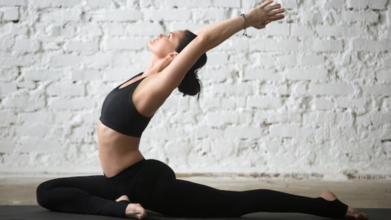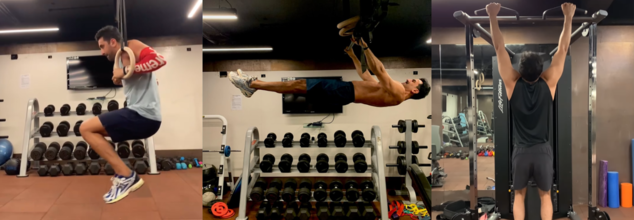- Health Conditions A-Z
- Health & Wellness
- Nutrition
- Fitness
- Health News
- Ayurveda
- Videos
- Medicine A-Z
- Parenting
- Web Stories

Yoga for Joint Health (Credit-Freepik)
5 Yoga Asanas You Must Do To Better Your Joint Health
Yoga is known to help people not only improve their health but even tackle some issues that they may have been suffering from, for a long time without any cure. This not only improves your mental health but also improves your lifestyle drastically. As we grow older, we start experiencing issues related to our back or our bones and yoga has always helped with that. Here are 5 Yoga poses that will help improve your joint health.
Hastottanasana
Hasta uttanasana, also known as the "Raised Arms Pose," is a standing backbend that's part of the Sun Salutation (Surya Namaskar) sequence. It's a great way to stretch your back and shoulders.
Here's how to do it:
- Stand tall with your feet shoulder-width apart and arms relaxed at your sides.
- Inhale and slowly raise both arms overhead, keeping them shoulder-width apart.
- Keep your legs straight and slightly bend your head and upper body backwards.
- Don't overexert yourself – go as far as feels comfortable.
- Exhale and return to the starting position.
Malasana
Garland Pose, also known as Malasana, is more than just a physical stretch. It's a grounding and calming pose that can help you feel more connected to your yoga practice and less distracted. This pose activates the Muladhara chakra, which is associated with stability and security. By focusing on this chakra, you may feel more grounded and centred. The name "Garland Pose" comes from the Sanskrit word "mala," which refers to prayer beads.
How to do Garland Pose:
- Squat down with your feet close together.
- Separate your thighs slightly wider than your torso.
- Lean forward and tuck your torso between your thighs.
- Press your elbows against your knees and bring your palms together in a prayer position.
- For a deeper stretch, reach your arms forward and wrap them around your shins.
- Hold for 30 seconds to 1 minute, then slowly rise to standing.
Samasthithi/Tadasana
Mountain Pose, or Tadasana, is a simple yet powerful pose that benefits your entire body and mind. Here's why:
Standing tall in Mountain Pose helps you align your body, stacking your shoulders, hips, knees, and ankles. This can counteract the slouching and tension caused by sitting at a computer for long periods. Mountain Pose enhances your awareness of your body's position and alignment. This awareness helps you make adjustments in other poses and daily activities.
How to do Mountain Pose
- Stand with your big toes touching and heels slightly apart.
- Lift and spread your toes, then lower them back down.
- Align your head, shoulders, hips, and ankles in a straight line.
- Let your arms hang naturally at your sides with palms facing forward.
- Gaze straight ahead and breathe deeply.
Stand with feet hip-width apart for better balance and to ease lower back tension. Gently rock back and forth and side to side on your feet. Gradually come to a standstill with your weight evenly distributed.
Paschimottanasana
Yoga offers a wide range of benefits for people of all ages and abilities. One particularly effective pose is Paschimottanasana or Seated Forward Bend.
Here's how to do it:
- Sit on the floor with your legs stretched straight out in front of you.
- Place your palms on the floor beside your hips.
- Exhale and reach forward, grabbing your big toes with your hands.
- Keep your back straight and lean forward, gently arching your spine.
- Bend your elbows and use them to pull your torso closer to your legs.
- Gradually bring your forehead towards your knees, resting it comfortably if possible.
- For deeper stretches, you can try holding your soles or resting your chin on your shins.
- Hold this position for 1-5 minutes, focusing on your breath.
Dhanurasana
Dhanurasana, or Bow Pose, is a powerful yoga pose with a range of benefits. Here's what you need to know:
Dhanurasana comes from the Sanskrit words "dhanush" (bow) and "asana" (pose). As you Dhanurasana can be helpful for managing back problems and improving flexibility. The pose also stimulates the digestive system, aiding in digestion and potentially reducing bloating. Dhanurasana is believed to have a positive impact on both physical and spiritual well-being.
How to do it
- Lie on your stomach with arms by your sides and legs stretched out.
- Bend your knees and reach back to hold your toes (or use a strap if needed).
- Inhale and lift your chest and thighs off the ground, creating a bow-like shape.
- Keep your head and neck relaxed, looking slightly upwards.
- Hold for a few breaths, then gently release and return to the starting position.

Credits: Canva
Is Running Enough For Leg Day Workout?
When you're a consistent runner, it feels like it's leg day, every day. Your quads, glutes, hamstrings, and calves are working hard — taking you up steep inclines, powering you through speed intervals, and carrying you to the finish line. So you naturally want to know: if you're running regularly, do you no longer need to do lower-body strength training?
The quick answer, not exactly. While running definitely makes your legs stronger in certain ways, it doesn't entirely substitute for the special benefits that result from traditional strength training. Here's what you need to know about how running develops strength, why strength training is still important, and how to strategically balance both for peak performance and injury prevention.
How Running Strengthens Your Muscles?
Running creates a specific kind of strength called strength endurance. This is the ability of your muscles to produce force repeatedly over a long time. Each time you take a step, there's repetitive muscle contraction building you up for sustained effort, much like performing a high-rep, low-weight exercise. Rather than lifting dumbbells, you're lifting your own body weight step after step.
In addition, running — especially when involving hill sprints, speed intervals, and strides — can create a bit of explosive strength, or the capacity to produce a large amount of force in a short time. If your runs, however, consist primarily of steady paces on flat surfaces, you won't be tapping into this kind of strength.
What running does not effectively build up is maximal strength — your capacity to generate the most force during one effort. Maximal strength training generally demands that you lift heavy weights for few repetitions, a stimulus running by itself just cannot offer, regardless of distance or speed.
Why Strength Training Still Matters for Runners?
Developing various kinds of strength depends on the idea of progressive overload: progressively putting more demands on your muscles by using heavier loads, more repetitions, less rest, or harder movements. Although running can incorporate some progressive overload — say, by adding mileage or hill sprints — there's a real-world and biological limit to how much you can push this.
Amplifying run volume significantly heightens your vulnerability to overuse injuries. Higher increases in training load were also associated with a greater incidence of injury among runners training for the New York City Marathon, a 2022 British Journal of Sports Medicine found. Not every athlete can or should go from 30 to 60 miles per week attempting to add greater strength — too often, risk just isn't worth the potential reward for many athletes.
Conversely, traditional resistance training provides a safer, more targeted, and more effective means of gradually increasing your muscle overload. Through lifting heavier weights, varying rest times, experimenting with tempo, and doing compound exercises such as squats, lunges, and deadlifts, runners can enhance maximal strength without having to significantly boost their mileage.
This additional strength translates back into your running: stronger muscles mean greater running efficiency, better injury resilience, and the ability to maintain good form even when fatigue sets in during longer distances.
Finding the Right Balance Between Running and Strength Training
If you’re wondering how to fit strength work into your running routine without feeling perpetually sore or exhausted, the key lies in smart scheduling and recovery.
Begin with strength training once or twice a week, preferably on hard run days to make your easy days really easy. Focus on full-body strength sessions, but pay particular attention to the lower body, core, and posterior chain (glutes, hamstrings, back). Most importantly, prioritize proper form and controlled movements over lifting as heavy as possible from the start.
Let your body adjust slowly. Sure, you may be a bit sore initially — especially if you haven't been doing much strength training — but eventually, your body will learn to cope with the increased stimulus. In the long term, the reward in enhanced running performance and decreased risk of injury is well worth the initial investment.
Is Running by Yourself Leg Day?
While running does develop muscular endurance and some explosive power, it doesn’t provide the maximal strength benefits that structured resistance training delivers. Therefore, if you’re serious about being a stronger, faster, and healthier runner, running alone shouldn’t be your only form of leg training.
Consider running and strength training as two pieces of a larger, holistic fitness puzzle. Both play a distinct but equally valuable role in supporting your performance, longevity, and athleticism.
Why Daily Running Provides More Benefits Than You May Realize
Daily running, when approached thoughtfully and with proper recovery, can provide a wide range of physical and mental health benefits that go far beyond cardiovascular fitness.
1. Enhanced Cardiovascular Health
Regular running makes the heart stronger, enhances blood flow, reduces blood pressure, and minimizes the risk of heart disease.
2. Better Mood and Mental Well-being
Running increases endorphins — the "feel-good" hormones — and has been associated with lower depression and anxiety rates.
3. Increased Muscle and Bone Strength
Consistent weight-bearing exercise such as running builds bone density and preserves muscle mass, particularly useful with age.
4. Improved Weight Control
Running burns a large number of calories and can aid in maintaining a healthy weight or losing weight when combined with well-balanced eating.
5. Longer Life
Several studies indicate that consistent runners have decreased death rates and longer lives than do non-runners.
6. Sounder Sleep
Consistent exercise such as running aids in keeping your sleeping cycle in check, thus falling asleep and sleeping better.
7. Cognitive Advantages
Running has been proven to improve cognitive ability, memory, and even induce neurogenesis — the creation of new brain cells.
However, it's crucial to listen to your body. Adding in easy runs, cross-training, strength training, and some rest days will serve to avoid overuse injuries and have you running well for many years to come.

Credits: Instagram
How Ranbir Kapoor Transformed His Body For ‘Love and War’
We have seen many actors often undergoing rigorous physical training to prepare for demanding roles. They also push their bodies beyond usual limits. One such star currently making waves for his dedication and fitness regime is Ranbir Kapoor. He is undergoing an intense training for Sanjay Leela Bhansali's upcoming film Love and War, which is set to release next year. The film also stars Alia Bhatt and Vicky Kaushal.
A glimpse from Ranbir Kapoor's workout was shared on the Instagram, which left many fans and fitness enthusiasts in awe. His trainer, Nam, shared the behind-the-scenes image of the actor performing a front lever- one of the most challenging calisthenic exercises. The image also showed Ranbir's core strength, balance, and control. It also inspired many to push their own workout limits.
What Is A Front Lever?
The front lever is an advanced calisthenic exercise where the body is held parallel to the ground while suspended from a bar. It is a full body challenge with the only point of contact being the hands gripping the bar.
How can you perform a successful front lever?
Core Strength: The abdominal muscles and obliques work intensely to keep the body straight and stable.
Back and Shoulder Engagement: The latissimus dorsi (lats), traps, and deltoids support and control the body’s position.
Grip and Arm Power: A strong grip and enduring forearms are essential to maintain the hold without sagging.
Full-Body Coordination: The front lever is a compound movement, requiring synchronized muscle engagement for balance and stability.
In the shared image, Ranbir maintains a flawless posture, holding his body completely straight and parallel to the ground. His execution reflects immense strength, remarkable control, and serious commitment to mastering his physical abilities.
What Are The Benefits of Front Lever Exercise?
Full-Body Strength: This exercise activates multiple muscle groups simultaneously, making it an excellent full-body strength builder.
Enhanced Core Stability: With continuous core engagement, it helps improve overall balance, posture, and athletic performance.
Upper Body Power: Strengthening the lats, traps, shoulders, and arms helps improve other key exercises like pull-ups, muscle-ups, and deadlifts.
Grip Endurance: Holding a front lever builds serious grip strength, which is useful not just for workouts but for daily activities.
Functional Fitness: It improves body awareness and control, skills that are important across various sports and everyday movements.
What Does Ranbir Kapoor's Fitness Regime Look Like?
Ranbir Kapoor's fitness journey has progressed steadily and many have witnessed it, including people who have seen the recently shared post by his fitness trainer. Hie trainer Nam had been sharing glimpses of the hard work Ranbir is putting into his regime.
It started about four months ago, where a video showed Ranbir performing pull-ups with an advanced clap variation. It also showed his agility and upper body strength.
Furthermore, the post had made it clear that his transformation for Love and War is more than just looking good on the screen. It is about his intense training regime, and the unwavering discipline that he has also encouraged to his fans to follow.

Credit: Canva
7 Effective Wrist Exercises to Boost Strength, Flexibility And Prevent Injury
Wrist strengthening exercises play a crucial role in building muscle strength, improving flexibility, and enhancing the range of motion in the wrist joints and tendons. They are particularly beneficial for athletes like boxers, gymnasts, and tennis players, as well as individuals at risk for conditions such as carpal tunnel syndrome. Regular wrist exercises can help prevent injuries and improve overall wrist health.
Many wrist exercises can be performed easily at home using light weights like dumbbells or household items such as water bottles or soup cans. However, it’s wise to consult your healthcare provider before starting any exercise routine to ensure it’s safe for your medical condition. A physical therapist can also guide you through the correct techniques to avoid strain or injury.
Finger Stretch
A simple stretch can effectively warm up your wrists and fingers before moving on to more demanding exercises. Begin by sitting comfortably with your elbow bent at a right angle. Make a fist, then slowly open your hand, stretching and spreading your fingers wide. Perform several repetitions with both hands. This exercise is also helpful during activities that require repetitive motion, like typing.
Wrist Extension With Dumbbell
For this exercise, sit in a chair with your forearm supported on a table and your hand hanging over the edge, palm facing down. Holding a 2- or 3-pound dumbbell, slowly lift your hand toward the ceiling, keeping your forearm steady. After fully extending your wrist, hold briefly, then lower it back down. Aim for two to three sets of 10–15 repetitions. Beginners can start without weights and gradually progress.
Dumbbell Wrist Flexion
Continuing with the dumbbell, flip your hand so your palm faces the ceiling. Flex your wrist upward, lifting the weight toward the ceiling, hold for a few seconds, and return to the starting position. Complete two to three sets of 10–15 repetitions. Like extensions, this flexion movement can also be practiced without weights by gently pulling your hand back with your other hand.
Prayer Stretch
To stretch the wrists and forearms, press your palms together just below your chin in a prayer position. Keeping your fingers together, slowly lower your hands until you feel a stretch along the inner arms. Hold for 15–30 seconds and repeat two to four times.
Steeple Stretch
Start in the prayer position and splay your fingers and thumbs apart as wide as possible, then bring your palms back together. Perform several repetitions throughout the day to maintain flexibility.
Wrist Supination With Dumbbell
Wrist supination involves rotating your wrist so your palm faces up. Sit with your forearm on a table and your wrist over the edge, holding a light dumbbell like a hammer. Slowly turn your hand until your palm faces the ceiling, hold, then return to the start. This exercise can also be done without weights.
Wrist Pronation With Dumbbell
The opposite of supination, pronation means turning your wrist so your palm faces downward. Hold the dumbbell vertically and rotate your wrist until your palm faces the floor. Perform two to three sets of 10–15 repetitions. For balanced strengthening, alternate between supination and pronation exercises.
© 2024 Bennett, Coleman & Company Limited

